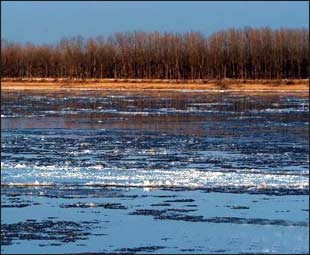| Home / Environment / Photo News | Tools: Save | Print | E-mail | Most Read |
| Warmer Weather Eases Yellow River Ice Problem |
| Adjust font size: |
Higher temperatures have eased problems with ice at the mouth of the Yellow River,
Freezing temperatures saw the frozen section in the lower reaches of the river stretch to a dozen kilometers on Monday morning, according to the Yellow River Flood Control Office of Shandong Province.
But higher temperatures Tuesday reduced the ice downstream of Despite the upstream freeze the river was flowing steadily at 300 cubic meters per second but less in the lower reaches. This made serious ice problems unlikely. Experts said the river's three-months of ice, December to February, occurs when the temperature falls below minus 10 degrees Celsius. The lower reaches of the river experienced ice in late December last year. Local flood control officials said they were prepared for embankment patrols, rescue operations and to break up the ice using explosives. Stretches of the river freeze and thaw at different times. When the water from a thawed section flows to a frozen stretch it can be blocked by ice. If the ice blockages hold back the water, the levels can rise, cause flooding and even burst dams. This can pose a threat to life and property. The 5,464-km Yellow River, popularly known as China's Mother river, starts in Qinghai Province in the northwest and flows through Gansu, Ningxia, Inner Mongolia, Shaanxi, Shanxi and Henan, before passing through Shandong and entering the Bohai Sea. (Xinhua News Agency |
| Tools: Save | Print | E-mail | Most Read |
 |
| Related Stories |
|
|||
